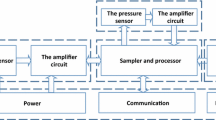Abstract
Background
Measurement of oxygen uptake (\( \dot {V}_{{{\rm{O}}_{{\rm{2}}} }}\)) should help detect non-steady state critical events and metabolic derangement during anesthesia. \( \dot {V}_{{{\rm{O}}_{{\rm{2}}} }}\) requires measurement of respiratory relative humidity (RH) and temperature (T). We have developed a fast response T and humidity sensor (HS), which uses tiny wet and dry thermometers to determine RH by psychrometry, where low RH causes evaporation to decrease wet T below dry T. In laboratory bench studies, we determined that ≥5 l/min gas flow through the HS is required for valid psychrometry function. This study demonstrates that monitoring of flow through the HS enhances the accuracy of RH measurement and interpretation.
Methods
Phase One: Laboratory bench validation; We designed a special bench setup for the validation of metabolic gas exchange compared to precise ethanol combustion. Phase 2: Clinical study; During mechanical ventilation of 6 anesthetized surgical patients, airway flow was used to successfully select valid wet T and dry T during inspiration and expiration, from which respective RH’s were calculated using principles of psychrometry.
Results
The average (±SD) percent error for airway \( \dot {V}_{{{\rm{CO}}_{{\rm{2}}} }}\) (compared to the stoichiometric value) was −1.84 ± 2.69% (Table 2). The average (±SD) percent error for airway \( \dot {V}_{{{\rm{O}}_{{\rm{2}}} }}\) was 0.91 ± 3.10%. Average RQ was 0.649 ± 0.017.
For all patients, average inspired RH was 36.1 ± 11.8% (range of 17–52%), which differed significantly from expiration (103 ± 9%). Among the 6–8 consecutive breaths for each patient, average standard deviations of expired RH were only 0.6%.
Conclusion
We conclude that airway flow monitoring enhances the interpretation and accuracy of the fast-response HS measurements during inspiration and expiration, allowing for the determination of \( \dot {V}_{{{\rm{O}}_{{\rm{2}}} }}\) in patients during anesthesia.
Similar content being viewed by others
References
Rosenbaum A, Breen PH (2003) Novel, adjustable, clinical bymixer measures mixed expired gas concentrations in anesthesia circle circuit. Anesth Analg 97:1414–1420
Breen PH, Isserles SA, Taitelman UZ (2000) Non-steady state monitoring by respiratory gas exchange. J Clin Monit 16:351–360
Ultman JS, Bursztein S (1981) Analysis of error in determination of respiratory gas exchange at varying FIO2. J Appl Physiol 50:210–216
Breen PH, Isserles SA, Harrison BA, Roizen MF (1992) Simple computer measurement of pulmonary VCO2 per breath. J Appl Physiol 72:2029–2035
Breen PH (2000) Importance of temperature and humidity in the measurement of pulmonary oxygen uptake per breath during anesthesia. Ann Biomed Eng 28:1159–1164
Breen PH. Fast response humidity and temperature sensor device (patent). United States Department of Commerce, Patent and Trademark Office, U.S. Patent Number 6,014,890, 2000
Morris E. Humidity measurement. In: Bentley RE, ed, Temperature and humidity measurement, Singapore, Springer-Verlag Pte. Ltd., 1998; 133–223
Sonntag D (1990) Important new values of the physical constants of 1986 vapour pressure formulations based on ITS-90, and psychrometric formulae. Zeitsch Meteorol 40:340
Rosenbaum A, Breen PH (2002) Fast response sensor measurement of airway humidity is enhanced by airway flow monitoring (abstract). Anesth Analg 94:S-148
Rosenbaum A, Kirby WC, Breen PH (2004) Measurement of oxygen uptake and carbon dioxide elimination utilizing the bymixer: validation in a metabolic lung simulator. Anesthesiology 100:1427–37
Altman DG, Bland JM (2002) Commentary on quantifying agreement between two methods of measurement. Clin Chem 48:801–802
Irlbeck D (1998) Normal mechanisms of heat and moisture exchange in the respiratory tract. Respir Care Clin N Am 2:189–198
Miyao H, Hirokawa T, Miyasaka K, Kawazoe T (1992) Relative humidity, not absolute humidity, is of great importance when using a humidifier with a heating wire. Crit Care Med 20:674–679
Martin C, Thomachot L, Quinio B, Viviand X, Albanese J (1995) Comparing two heat and moisture exchangers with one vaporizing humidifier in patients with minute ventilation greater than 10 l/min. Chest 107:1411–1415
Kollef MH, Shapiro SD, Boyd V, Silver P, Von Harz B, Trovillion E, Prentice D (1998) A randomized clinical trial comparing an extended-use hygroscopic condenser humidifier with heated-water humidification in mechanically ventilated patient. Chest 113:759–767
Full support by National Heart Lung and Blood Grant R01 HL-42637 (P.I.: P.H. Breen). Additional partial support from the Department of Anesthesiology, University of California-Irvine and National Center for Research Resources Grant M01 RR00827.
Author information
Authors and Affiliations
Corresponding author
Additional information
Rosenbaum A, Breen PH. Importance and interpretation of fast-response airway hygrometry during ventilation of anesthetized patients.
Rights and permissions
About this article
Cite this article
Rosenbaum, A., Breen, P.H. Importance and Interpretation of Fast-Response Airway Hygrometry During Ventilation of Anesthetized Patients. J Clin Monit Comput 21, 137–146 (2007). https://doi.org/10.1007/s10877-006-9065-5
Received:
Accepted:
Published:
Issue Date:
DOI: https://doi.org/10.1007/s10877-006-9065-5



